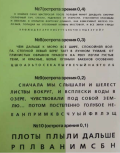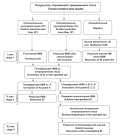ORIGINAL ARTICLES
Myopia is one of the most urgent problems of modern ophthalmology. Statistics show that the number of children and adolescents suffering from myopia is steadily increasing worldwide. But it also noted that in different regions of the Russian Federation, the proportion of children who are diagnosed with myopia may differ markedly. Purpose: to determine the prevalence and structure of myopia in schoolchildren of the city of Krasnoyarsk, depending on age and gender. Materials and methods. A survey of 3005 students of secondary schools in the city of Krasnoyarsk aged from 6 to 18 years, including 1,421 schoolboys and 1,584 schoolgirls, was conducted. Refraction was determined after cycloplegia using the autorefractometry method. Results. The predominant type of refraction in primary school students of both fi elds is emmetropia, myopia is in second place and other refractive errors are in third place. The prevalence of myopia in schoolchildren increases as they grow up. At the same time, in the schools of the city of Krasnoyarsk, already in the primary grades in the group of subjects of both sexes, the proportion of students with myopia was 17.9 %, in the middle – 36.8 %, and by the high classes it reached 49.7 %. When considering the data obtained, depending on gender, approximately the same proportions of myopia were found in primary grades in both schoolgirls (19.2 %) and schoolchildren (16.7 %), in middle grades, a statistically significant predominance of myopic refraction in girls, compared with boys (42.8 and 29.5 %, respectively, p < 0.05). In high school, the proportion of myopia increases both in girls to 52.1 % and in boys to 47.2 %. The proportion of subjects with emmetropic refraction decreases as individuals of both sexes grow up. The percentage of other refractive errors remains without significant gender-age changes. Low myopia was the most common in all groups, but its percentage significantly decreased as they moved to higher grades, simultaneously with an increase in the proportion of moderate and high myopia. Conclusions. There is an increase in the prevalence of myopia in schoolchildren as they move to higher grades. A threefold increase in the proportion of myopia in high school compared with primary school was revealed. It is necessary to further study the prevalence of myopia in all Russian regions and develop preventive programs to control myopia in children.
Background: Functional and organic ophthalmopathology can cause reading diffi culties in children. Color diagnostics and color correction represent promising areas in the care of such patients. However, there are currently very few publications devoted to this topic. Purpose: The aim is to determine the most effective Methods for assessing the effect of color on visual acuity and reading speed in children with ophthalmopathology. Materials and methods: A total of 51 schoolchildren aged 10 to 16 years were observed, divided into: 1) 17 children the control group with high visual acuity; 2) 17 children with mild bilateral amblyopia; 3) 17 children with congenital partial atrophy of the optic nerve of both eyes (PAON). To study the effect of the color background on visual perception in all groups, we used: 1) the B.Bourdon test with paper of different colors; 2) assessment of visual acuity with a standard test and with colored overlays; 3) eading speed assessment on a white background and with colored overlays. Results: Indicators of the volume of attention according to the B. Bourdon test with a pink background were lower in the group of children with PAON compared with children with amblyopia (p = 0.012). Signifi cantly less attention with a blue background was observed in the group of children with PAON compared with the control group (p = 0.04). The use of individually selected color overlays allowed 64.7 % of children with amblyopia and 76.5 % of children with PAON to increase visual acuity for close range by 0.1–0.2, as well as increase reading speed by 17.6–19.2 % in amblyopes and by 31.1–31.2 % in children with PAON. Conclusion: The use of color overlays is the most effective and convenient method for assessing the impact of color on visual functions. The individual selection of color overlays in most children with amblyopia and PAON improves visual acuity for close range and increases reading speed.
Introduction. Brown’s syndrome (BS) is a rare type of unconcomitant strabismus, which is often interpreted by practicing ophthalmologists as a paralytic form. The difficulty of diagnosis is due to the similarity of clinical manifestations with a number of other oculomotor disorders. This leads to a late, and most importantly, tactically incorrect choice of surgical treatment method. Purpose: Development of an algorithms for differential diagnosis and surgical treatment of Brown syndrome. Materials and methods. The authors analyzed the experience of diagnosing and treating 99 patients with Brown’s syndrome. The follow-up period was 13 years, from May 2010 to May 2023. Among the examined patients, 35 (35 %) were male and 64 (65 %) were female. The median age was 7.19 ± 0.87 years, the oldest at the time of the study was 45 years old, and the youngest was 1.5 years old. All patients underwent standard ophthalmologic and strabismal examinations. In patients of verbal age, the nature of vision was examined (Worth test, Bagolini test, double Maddox test). All operated patients underwent a cyclotorsion test intraoperatively under general anesthesia to confirm the diagnosis and choose a surgical method. Surgical treatment was carried out in 60 cases of unilateral and 5 cases of bilateral BS (a total of 65 patients aged 2 to 45 years; 69 eyes). Tenotomy and tenectomy of the superior oblique muscle (ECM) were performed in 53 cases, prolongation and recession with prolongation of the ECM in 16 cases. Results. Clinical signs have been systematized, algorithms for differential diagnosis and surgical treatment have been developed, which make it possible to timely identify Brown’s syndrome and carry out stage-by-stage pathogenetically based surgical treatment. The results are presented in the form of sequential action schemes (algorithms) that will help practitioners in making a diagnosis and determining the correct tactics of surgical treatment. Conclusions. Brown syndrome has characteristic differential features and requires staged surgical treatment. Developed algorithms to obtain high functional and cosmetic results.
Background. The occurrence of infectious complications in the early postoperative period in patients undergoing ophthalmic surgery remains a persistent challenge in contemporary clinical practice. Typically the treatment regimen involves the administration of a combination of antibiotics and corticosteroids, often utilized in a fixed-dose combination for simplicity. Despite the prevalent use of these regimens, there’s a notable disregard for comprehensive microbiological diagnostics of the conjunctiva in surgical patients, attributed to various socio-economic factors. However, the significance of such diagnostics in forecasting postoperative outcomes is indisputable. Purpose of the study: to determine the medical and economic feasibility of prescribing individual antibacterial and anti-inflammatory medications in fixed combinations (FC) in postoperative treatment regimens for patients scheduled ophthalmic surgeries. Materials and methods. The study included data from 99 patients (65 males and 34 females, mean age 74 (70–77) years) admitted for elective surgery to address cataracts or glaucoma from May to September 2023. Patients were randomly divided to 2 observation groups. The division into groups was carried out according to the drugs (medicines) used in the postoperative treatment regimens, each of which was further divided into 2 subgroups in accordance with ophthalmopathology. The first group of patients received postoperative therapy with the levofloxacin/dexamethasone FC (L-dexopt, RK.O. Rompharm Company S.R.L., RU LP-007490), the second group was treated with a tobramycin/dexamethasone FC (Tobrazon, Kadila Pharmaceuticals, RU P№015176/01). All subjects underwent a comprehensive ophthalmological examination, as well as a microbiological examination of the conjunctival cavity before surgery and 8 days after surgical treatment. Additionally, all patients completed the Ocular Surface Disease Index (OSDI) questionnaire. Results. Analysis of microbial flora changes during therapy revealed an increase in cultures exhibiting a “zero” degree of growth by 29 and 11,1 % in the “cataract” and “glaucoma” subgroups of the fi rst observation group, respectively. The second group showed a similar increase. “zero” degree of growth (11,7 and 28,6 %, respectively). The treatment costs for patients undergoing cataract surgery and receiving the FC levofloxacin/ dexamethasone were 105.9 rubles per treatment course, compared to 40.5 rubles for those undergoing surgery for glaucoma or complicated cataracts. The cost-effectiveness for those treated with the FC tobramycin/dexamethasone in the early postoperative period was 21,6 and 51,9 rubles. respectively. The OSDI scores across in all subgroups ranged from 16,6 to 25,0 points indicating normal values. The administration of FC levofloxacin/dexamethasone and tobramycin/dexamethasone in the early postoperative period for patients with cataracts and glaucoma was clinically effectively in managing the inflammatory process by influencing the microbial spectrum (microbiome) of the ocular surface. No significant differences were observed in the degrees of microflora growth during the preoperative period between the “cataract” and “glaucoma” subgroups, which does not support the hypothesis regarding the antiseptic action of topical antiglaucoma medications in patients with glaucoma at this stage. Conclusions. The conducted medical and economic analysis proved the feasibility of using both drug combination with a slight preference FC levofloxacin/dexamethasone in patients undergoing surgery for glaucoma and FC tobramycin/dexamethasone for those with uncomplicated cataracts in the early postoperative period.
REVIEWS
Introduction. In the light of E.S. Avetisov’s hereditary-physiological theory of the pathogenesis of myopia and works devoted to the infl uence of peripheral myopic and hyperopic defocus on refraction, it makes sense to consider myopia as a multifactorial disease, so patients with myopia should receive comprehensive monitoring and treatment from related specialists. However, in practice, the general somatic status of patients and the presence of concomitant diseases in them are often not studied. Purpose: to analyze literature data on the impact of patients’ comorbidities on their wearing of contact lenses, to assess potential risk factors in such patients, and to draw the attention of an ophthalmologist to the importance of a complete clinical examination. Materials and methods. An analysis was made of publications on such resources as Pubmed, eLibrary, Medline over the past 30 years. 43 literature sources were analyzed, of which 37 were published no later than 10 years. Results. The authors of these publications describe how taking drugs from the group of retinoids, the presence of allergic conjunctivitis, thyroid diseases, rheumatoid arthritis, diabetes mellitus, and the characteristics of the patient’s psycho-emotional state can infl uence the incidence of complications when using contact lenses. Conclusions. Taking into account numerous studies on the relationship between the progression of myopia and general somatic diseases, as well as the features of contact correction in childhood with comorbidities, we can say that a complete clinical examination of each patient is of high importance.
Currently, the management of myopia represents a critical focus within the fi elds of optometry and ophthalmology. This the rapid proliferation of myopia across numerous nations notably those with extensive populations such as Russia, China, USA. Moreover, the increased interest in myopia management emerges from innovative optical correction methods specifically designed to slow the progression of myopia. Consequently, the presence of multiple optical intervention options necessitates judicious decision- making by clinicians regarding the selection of a particular method. The effectiveness of myopia control measures is further attributable to the development of a treatment plan and long-term dynamic observation. Such an approach allows for the timely modification of treatment protocols to ensure the stabilization of eye axial length growth and correction of. The term «Myopia progression management medical technology» is encompasses various procedures designed to prevent the onset of myopia, diagnose and treat progressive myopia, and assist physicians overseeing patients with myopia.
In this article, we will examine the role of the polymer chemist, the manufacturing lab, the practitioner and fi nally the patient, in providing the eye with the most comfortable and wettable GP contact lens possible.
WORKSHOP
LITERARE GUIDE
NEWS: WHAT? WHERE? WHEN?
ISSN 2686-8083 (Online)

































